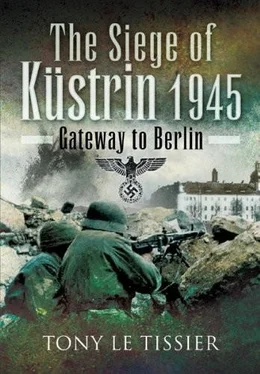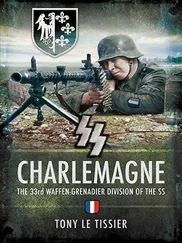Back in Küstrin there was concern over the state of the ice on the Oder and Warthe rivers, which showed little sign of movement. During the first winter of the war the ice had formed metre-high barriers and in the subsequent thaw giant lumps of ice released from the flooded Warthe meadows had crushed the pontoons of the bathing stations. Damage to the bridges had only been avoided by some risky explosions with concentrated charges. Now attempts in several places to dislodge the ice with explosives proved ineffective, as the ice floes quickly froze back together in night temperatures as low as minus 20 degrees.
The cold and snow also made digging difficult. Firing positions and anti-tank ditches were prepared on the roads leading into the town from the east and south, from where the first attacks were expected; mines were laid and barbed wire obstacles erected. On the Landsberger Chaussee 14- and 15-year-olds tackled the deeply frozen earth, having to bring their own tools from home, under the direction of a few grumpy soldiers. Even the few picks passed from hand to hand were inadequate. Only when fires were lit over lines marked in the snow to warm the ground a little were they able to make small holes in the frozen earth and then laboriously extend them, but this took hours. Then someone forbade the lighting of fires for fear of attracting aircraft, although locomotives at the nearby goods station were sending thick smoke up to the low-hanging clouds.
When the work was abandoned at dusk, only a few shallow depressions showed the run of the planned position. The boys marched back to town frozen through and hungry, and were dismissed with orders to return to the position next morning. Even the prospect of further days without school failed to raise their spirits. Those born in 1928 and not already conscripted as Flak or naval auxiliaries had stopped attending regular classes since the last summer holidays. Until September they had worked on defences near Kalau, between Meseritz and Schwiebus, then had to assist with the root harvest near the town. This task was considerably pleasanter as they could sleep in the barns, were given good food with supplementary ration cards, and did not have to train or mount guard after work. They might even earn a few pennies. By this time, the schools had been concentrated into just a few schoolrooms, partly because the buildings were needed as hospitals or to house refugees. A few hours of tuition were given in shifts well into the afternoon, to which the teachers and pupils reacted only half-heartedly. And now this too was coming to an end. [2]
Panzergrenadier Johannes Diebe, who had only been a soldier since 15 January as a member of Panzergrenadier Replacement Battalion 50 in Küstrin, reported being employed on a similar task:
About six days before the end of the month our basic training was interrupted and we were sent to various locations to build defences. Our platoon had to go to Schlageterstrasse, beyond the entrance to Zeppelinstrasse, to dig foxholes near the GEWOBA buildings, one section to the left and one section to the right of the street. The distance between foxholes was about 2 metres.
Along the road from Alt Drewitz to Küstrin came an endless stream of refugees, civilians with horse-drawn wagons, hand carts, prams and packed bicycles. Among them were wounded soldiers, often with bloody bandages. Civilians, soldiers, officers, all had one aim, to cross the Warthe and the Oder and reach the west bank.
The people going past constantly asked us to go along with them. Fighting was useless in view of the Soviet superiority. Within us the sense of honour competed with the temptation to clear off. Flight seemed a possibility in this confusion, but one’s sense of honour was stronger.
While we were digging, a squad of Feldgendarmerie [military police] appeared from the town and established a control point in Schlageterstrasse. They began to ruthlessly comb the soldiers out of the stream of refugees, registering them and lining them up and sending them marching off to other destinations. Those who refused were either shot or hanged. Those hanged were given a label: ‘I am a coward’.
These events depressed us. The view of the four hanging soldiers along the street was unbearable. We therefore asked our superiors and the Feldgendarmerie to cut down the bodies of the comrades. The answer from the Feldgendarmerie was: ‘You lads can practise your shooting and shoot through the ropes, but your aim had better be good, or you can watch yourselves being hanged.’
We begged our section leader to agree to this proposal and the sergeant agreed. So we shot our dead comrades down from the trees. It was awful, but much better than having this view in front of our eyes. For the civilians, above all the children, this must have been a terrible sight.
The Feldgendarmerie moved their control point further back into the town. We noticed that from then on soldiers came to us, asking for our company command post. In doing so they remarked that nothing made sense any more. This way we acquired a staff corporal and another corporal in our section. The first wore the ribbons of both Iron Crosses next to his Close Combat Badge. He had got as far as Stalingrad and only being on leave from the front had saved him from encirclement, death or imprisonment there.
We learned a lot from the staff corporal and were always asking him what he made of the situation. He reckoned that there was not much chance of a Russian attack as long as refugees and German soldiers in the present numbers were still coming through. [3]
Corporal Hans Arlt was also involved in the preparations for war:
Following my successful conclusion of a course at the Army NCO School at Arnswalde, I was sent to the front together with some other comrades on 26 January 1945 as an RUB [Potential NCO of the Reserve] corporal. We were driven in open trucks to Küstrin-Neustadt in winter temperatures of minus 15 degrees Celsius.
We were assigned to the 2nd Company of Captain von Oldershausen’s combat team [battalion] in Stülpnagel Barracks. A considerable proportion of my platoon consisted of old soldiers who had been on guard duty in Denmark until then. They made themselves welcome to our group with their rich supplies of butter and cheese, but they were not really suited to the coming fighting.
I recall that there was a Feldgendarmerie company in Stülpnagel Barracks.
There were some garages at the rear of the barrack complex that contained large quantities of spare parts for various handguns, and we were all able to improve our personal arsenal by helping ourselves. I too acquired a 7.65mm pistol and obtained the necessary ammunition from the Feldgendarmerie company in exchange for cigarettes. Later a sentry put an end to this self-service.
Our steel helmets were coated with toothpaste for the winter fighting. On 30 January the 2nd Company deployed. Our platoon was located in deep woods outside the northern boundary of the Neustadt near the railway employees’ convalescent home. The position consisted of a row of rifle pits in which we spent the day and night. The frozen earth made digging in hard work. [4]
One early reinforcement to the Küstrin garrison was 17-year-old Luftwaffe-Auxiliary Fritz Oldenhage:
I was born in Stettin on the 7th April 1928. I was conscripted as a Luftwaffe auxiliary on the 5th January 1944, and soon afterwards my schooling came to an end. I was sent to the 3rd Battery, Light Flak Battalion 850 in Berlin and received my first training with the simple 20mm and 20mm quadruple flak as a gunlayer.
Following action in Stettin and its surroundings, for instance with 20mm quadruple flak at the goods station, protecting heavy and medium flak against Anglo-American aircraft, I was sent to Anklam to guard a flying field. There I was trained on the 37mm flak, telephone exchange operating and telephone line construction.
Читать дальше












